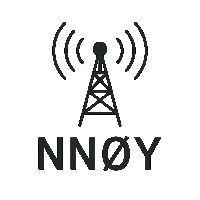Toroids
tl;dr: Order name-brand toroids from kitsandparts.com and avoid Chinese made toroids, as the name-brand toroids cost about the same and perform a little better.
I have been interested in the difference between “official” or name-brand electronics parts and Chinese clones/copies/ripoffs (whatever you want to call them). Who isn’t interested, especially when they are so cheap? I’ve been bitten in the past with Chinese Si5351 boards with weak or broken crystals, and the Si5351 couldn’t operate because it couldn’t get the PLL to lock. I have been able to fix some boards by replacing the crystal, but I’ve also had Chinese Si5351 boards where the crystal was fine but one of the PLL outputs was broken, and there is no repairing that. I also have been tinkering with an RF power amplifier kit where some components are clearly used and some resistor values are wrong. So to make a long story short, for some time I have been learning the hard way that it is worth it to buy kits from the original designers and places that have some supply chain guarantees. In the case of the Si5351, I’ve decided to only buy from Adafruit, and for HF radio kits, I am going to seek out kits that are packaged by the original designer.
Today I’m not going to do a full big experiment to estimate the exact quality degradation from Chinese parts, I just want to see if I can spot a difference in one category of intereset. The items of interest are iron powder toroids, commonly used in HF radios and antennas to create an inductance. By far the most well known manufacturer is Micrometals, and the most common toroids used in HF radios use the -2 and -6 mixes of carbonyl iron powder in various sizes. They are so well known that most other manufacturers list their parts as equivalent performance and adopt the Micrometals color codes, so they are basically an industry standard. The main reason I’m not doing a full experiment is that I don’t have the patience to wind and test more than a couple toroids at a time.
I have a few toroids pulled off a band pass filter board that I got from AliExpress. It was only a few dollars, so I figured that even if I didn’t like the filter itself I could strip it for parts (antenna connectors, toroids, capacitors, and switches) and basically break even. When I got it I measured a pretty high insertion loss >10 dB on my NanoVNA, so I decided it probably wasn’t worth keeping. I don’t know exactly what the cause of the high insertion loss was, it could be anything from bad solder joints, a lossy PCB design, or bad quality components. I didn’t think to investigate until after I had ripped it apart, so we’ll never know. But the fact that the finished band pass filter from China was not suitable for use is more evidence that Chinese parts are often not worth the effort. Imagine if I had gone out to use that in the field and thought I was cleaning up my signal, but was also reducing it so much that people couldn’t hear me! I probably would have wondered why nobody wanted to talk to me or spent forever trying to find the issue.
I think I need to note that Chinese made products can sometimes be worth it- I have a NanoVNA-F v3, TinySA Ultra+, and a Hantek Oscilloscope. All of these products meet my needs, and any performance quirks can be tolerated considering the price difference between them and name-brand American or European test equipment, which can literally cost 10x more. This is part of the frustration/challenge- sometimes a frugal ham is totally willing to put up with a slight performance drop in exchange for a big price difference, but unless someone else has already shelled out the money to do a side by side comparison we don’t have any idea what the performance difference is. This post is my attempt to contribute to one area.
The Toroids
But I kept the toroids I pulled off the worthless Chinese band pass filter in case I wanted to use them in a project. I have also succumbed to the temptations of Amazon and bought toroids from them. I have no idea where these toroids are manufactured. I have also ordered toroids from KitsAndParts.com, which is a good way to get official Micrometals toroids without a minimum purchase (I guess the minimum purchase is that they come in bags of 25). Here’s a picture comparing the Chinese origin toroids on the top row with the Micrometals on the bottom.
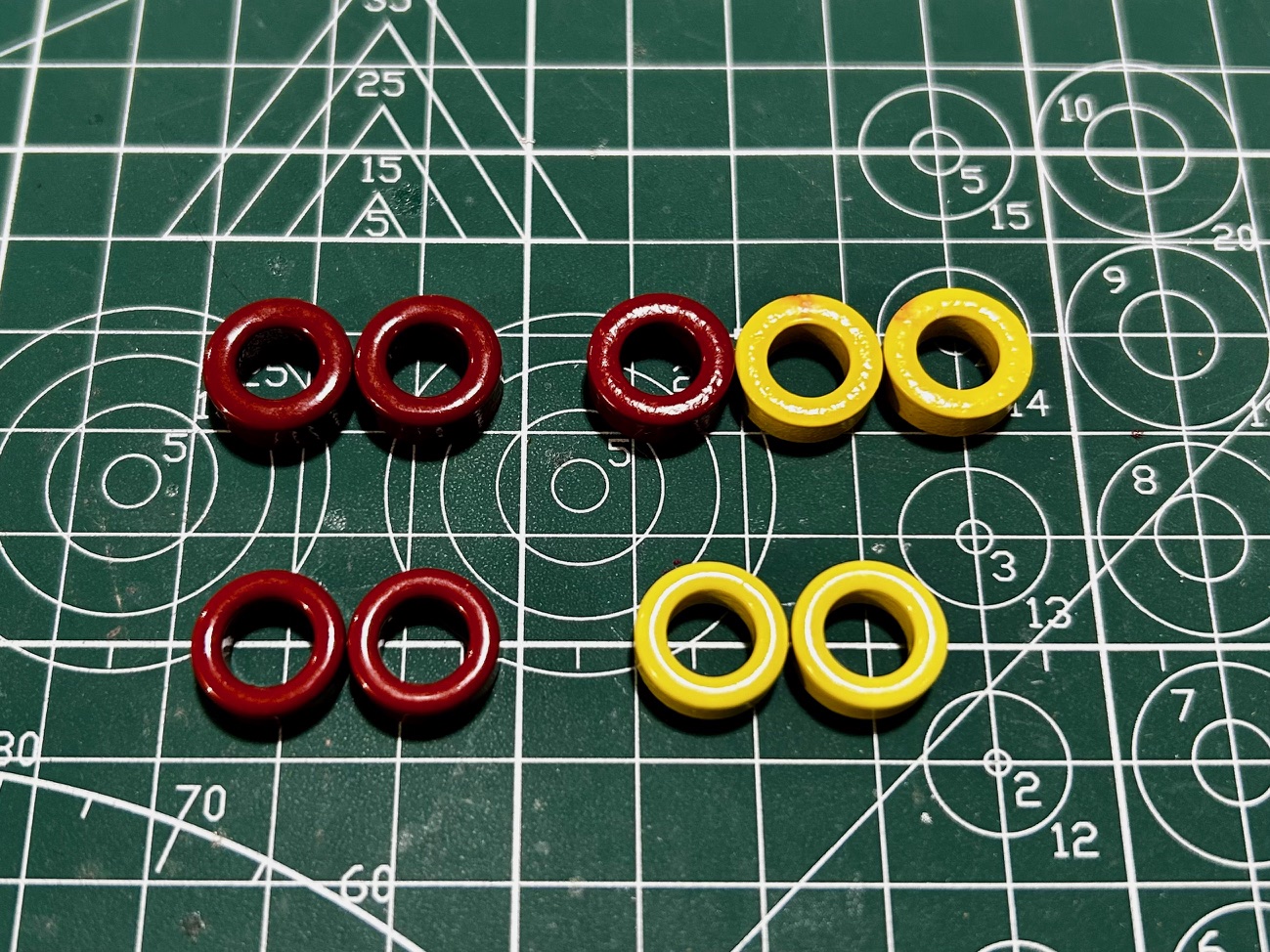
It is easy to tell the difference between the Micrometals and the Chinese toroids when they are next to each other. The Micrometals toroids have a noticeably better surface finish and are a different size. All of the toroids have about the same inner diameter, but the Micrometals are a bit thinner so they have a smaller outer diameter. So at first glance I suspect that the Micrometals are going to perform better since it looks like they have better quality control. But maybe the Chinese just didn’t waste money on their paint booth and their toroids work fine.
The RF performance
I took one toroid of each origin (China and Micrometals) and mix (-2, red, and -6, yellow), all of size T50, and wound 20 turns of 28 AWG enameled wire around them. The website toroids.info says that should produce an inductor of 1.96 uH on a T50-2 and 1.60 uH on a T50-6 toroid. The below pictures are the Chinese T50-2, the Chinese T50-6, the Micrometals T50-2, and the Micrometals T50-6 in descending order.

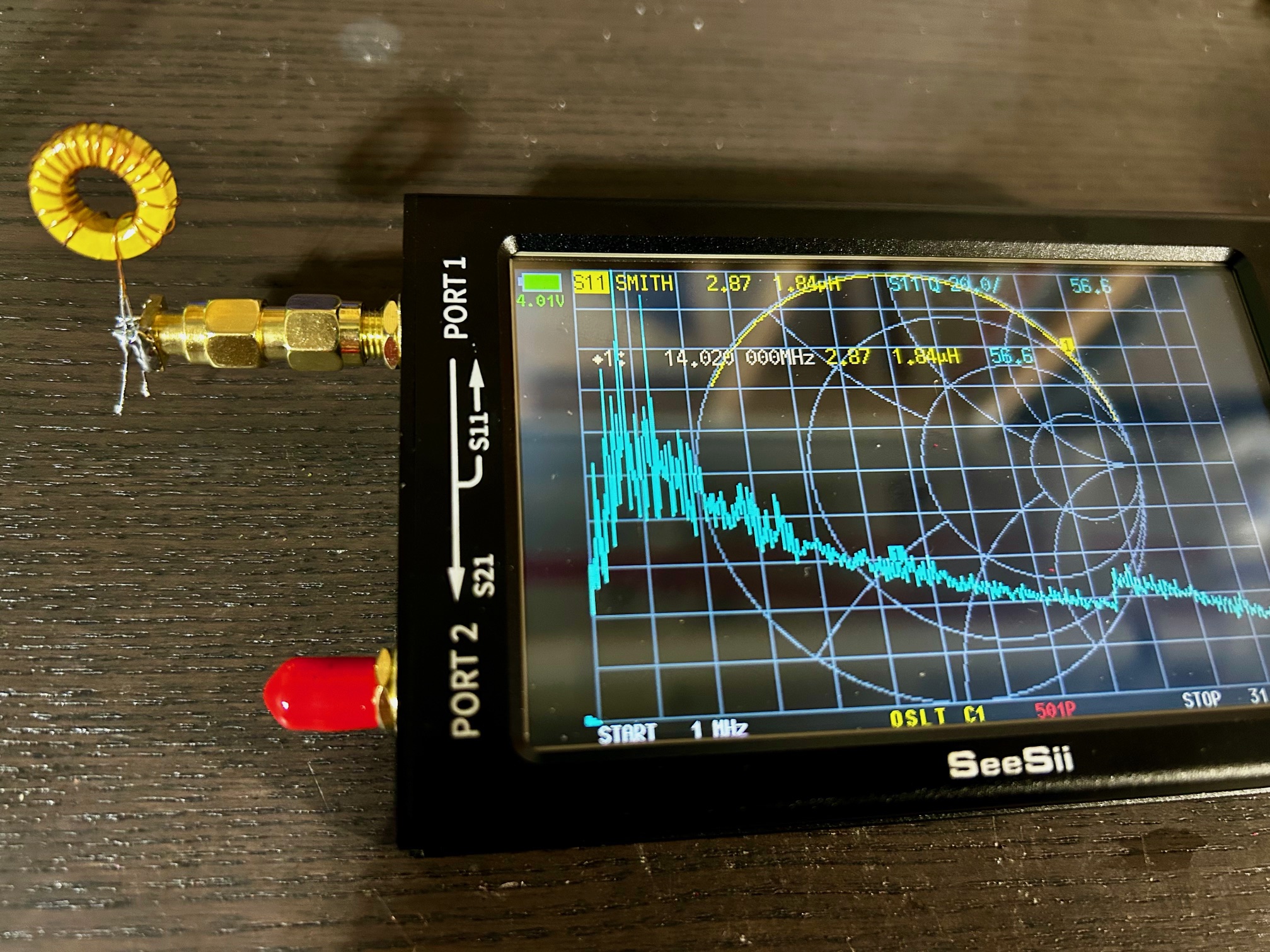
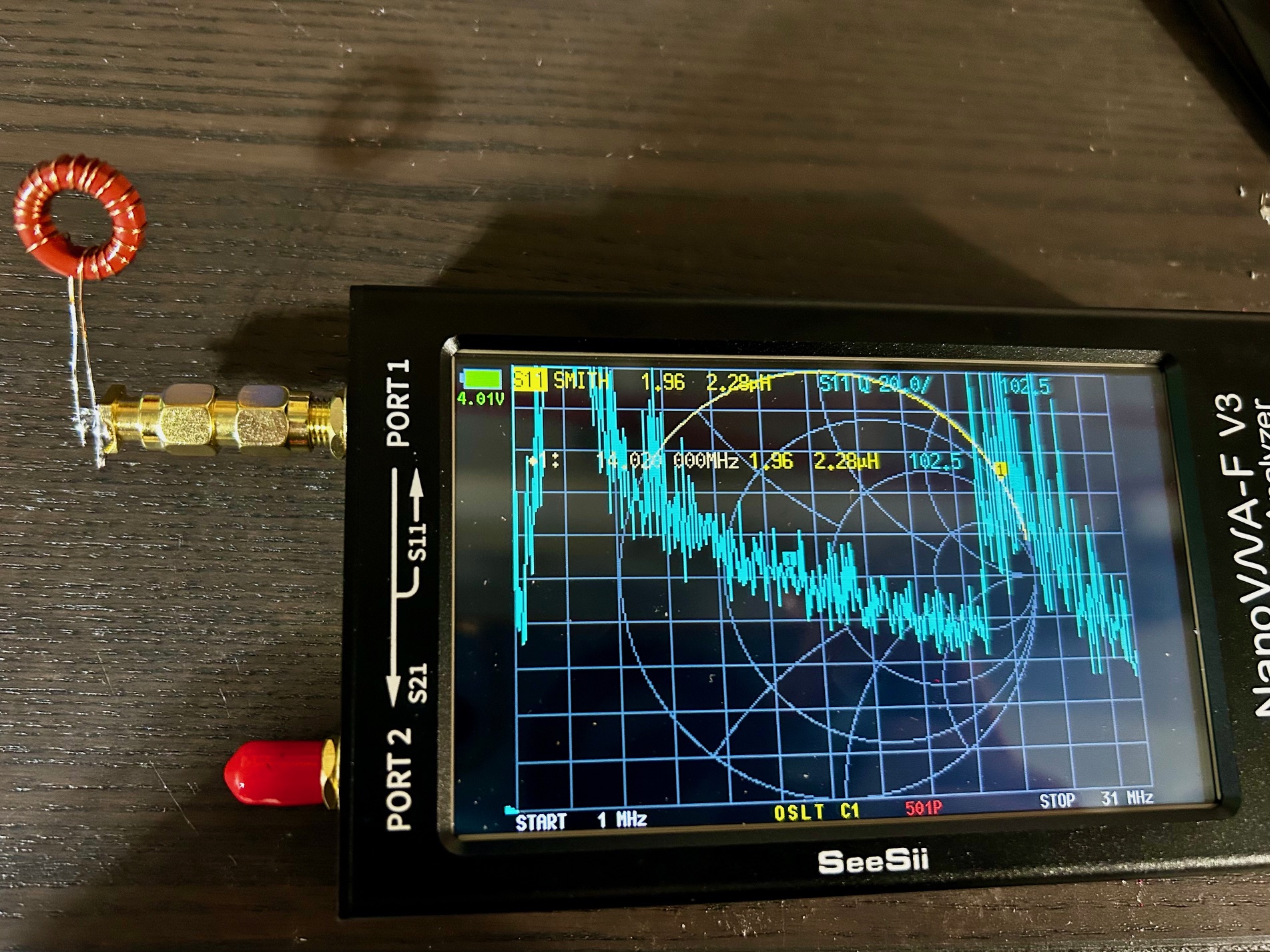
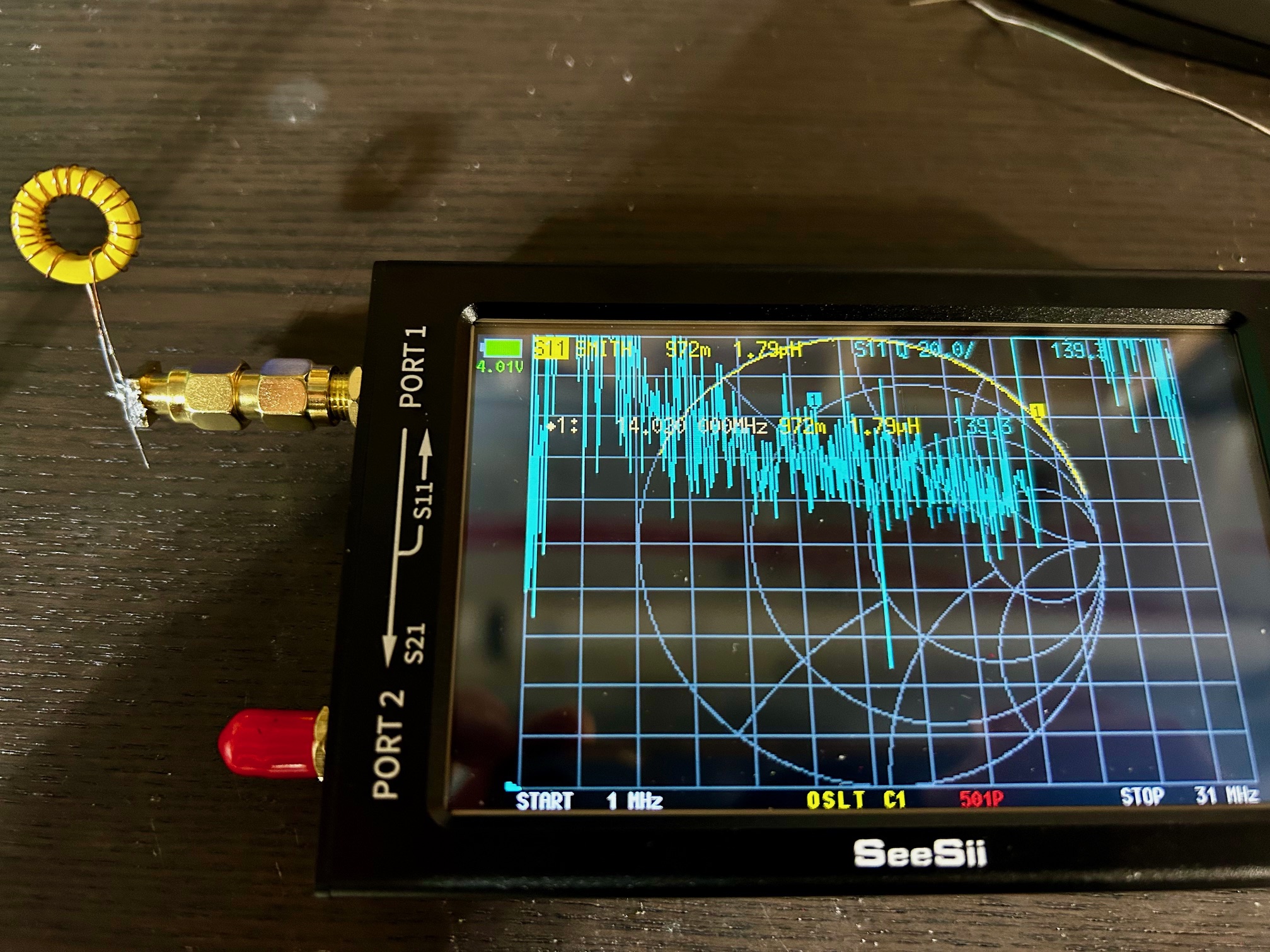
My NanoVNA measured the following results at 14.02 MHz. There is no special reason for this frequency, except that the 20M band is a good compromise between the bands I’m primarily interested in (40M-10M):
| Toroid | Inductance | Resistance | Q-factor |
|---|---|---|---|
| CH T50-2 | 2.07 uH | 2.13 Ohm | 85.8 |
| CH T50-6 | 1.84 uH | 2.87 Ohm | 56.6 |
| MM T50-2 | 2.28 uH | 1.96 Ohm | 102.5 |
| MM T50-6 | 1.79 uH | 0.97 Ohm | 139.3 |
Note 1: if you’re not familiar, the Q-factor (quality factor) of a toroid is the ratio between reactance (the imaginary component of impedance) and resistance (the real component of impedance). In general we want to use components with high Q-factor because the behave more like ideal components and have lower resistive losses.
Note 2: My VNA does something with the calibration around 23.5 MHz, which is why you see a step change in the blue Q-factor measurements there. It seems that the impedance measurements stay fairly consistent across the range, but the resistance measurements change as you cross 23.5 MHz. Since the actual resistance is ~2 Ohms, a small absolute change in resistance will cause a large change in Q-factor calculations. Since I wasn’t measuring near this place and the behavior is consistent across all the toroids I tested, I know it isn’t the toroid causing this behavior. However, this might lead us to suspect that we don’t have the most accurate reading of resistance, so I’ll choose to evaluate these measurements relative to each other rather than as an absolute measurement of resistance.
Conclusions
The Micrometals toroids are measurably the best option regardless of which mix you’re using, but surprisingly the Chinese toroids aren’t completely unusable- they deliver about the right inductance. The deciding factor is that (as of the time of writing) ordering from kitsandparts.com will only cost you $5 for a bag of 25 T50-2 toroids and $11 for a bag of 25 T50-6, plus a reasonable USPS shipping fee and they will arrive in about a week. They also have a huge selection of different sizes and mixes. At those prices it basically doesn’t make any sense to buy the Chinese toroids, whether as bare toroids or to pull them from kits.
While the performance difference in isn’t as extreme of a difference that I’ve seen with other Chinese electronics, it is affordable for me to just keep a stock of the common -2 and -6 toroids in my workshop, and not have to worry about shipping times or quality when starting a new project.
Footnote: I realize this might seem like an ad. It’s not. I have had no contact with KitsAndParts except for making an order, they just happen to be the most popular source for toroids in quantities suitable for a ham radio experimenter (not a mass-producer).
